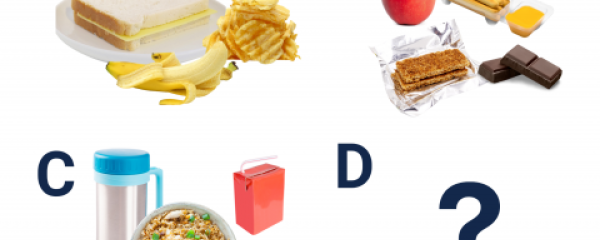What is it all about?
Students examine food product packaging to understand how food marketing techniques influence their perceptions about the nutritional value of food and their food choices. Students consider the effect of highly processed food on their health and the environment and create media messages to promote healthier food choices.
Curriculum Connections
Grade 1
Health & Physical Education: A1.1, A1.3, A1.5, A1.6, D1.1
Language - Media Literacy: 1.1, 1.2, 1.3, 1.4, 1.6, 2.1, 2.2, 3.4
Grade 2
Health & Physical Education: A1.1, A1.3, A1.5, A1.6, D2.2
Language - Media Literacy: 1.1, 1.2, 1.3, 1.4, 1.6, 2.1, 2.2, 3.4
Grade 3
Health & Physical Education: A1.1, A1.3, A1.5, A1.6, D1.1, D2.1
Language - Media Literacy: 1.1, 1.2, 1.3, 1.4, 1.6, 2.1, 2.2, 3.4
What is needed?
Samples of packaged foods that are minimally processed and highly processed (e.g., packaged fruit, packaged applesauce, flavoured fruit snacks, packaged fruit drinks).
How is it done?
- Facilitate a large-group discussion. Have students reflect on what they know about the difference between highly processed and minimally processed foods, including the differences in nutritional value and their impacts on a person’s health and on the environment. Use discussion prompts such as:
- Describe the difference between minimally processed foods and highly processed foods.
- What is the difference between:
- a baked potato and instant mashed potatoes;
- pre-packaged apple slices and sweetened applesauce; and
- a packaged dessert versus a fresh made dessert.
- Explain to students that most of the food we eat is processed in some way. Some foods are only processed a little to help preserve them and retain their nutrients, such as pre-packaged apple slices. Foods that are more highly processed are very different from how they were grown. The more the food is processed, the more nutrients it’s likely to lose. Some processed foods can be part of a healthy eating pattern. Food packaging can influence where we think the food was grown and how nutritious it might be. We have to think about these factors when deciding if a food is a nutritious choice.
- Select and display images or bring in a variety of packaged foods that are minimally processed and highly processed (e.g., pre-packaged fruit, canned vegetables, crackers, granola bars).
- Have students examine the food packaging and ask them to identify the words, images, and colours used to convey messages about the origin and nutritional value of the food (e.g., words such as life, healthy, freshly baked; images of fresh fruit, vegetables, growing grains, or a farmer on a cereal box; milk on a box of cookies; or colours such as green used to convey “freshly grown,” yellow to convey wholesome food, and white to convey purity or cleanliness).
- Facilitate a large-group discussion. Have students identify the messages conveyed through the product packaging and how the messages are designed to influence their food choices. Use discussion prompts such as:
- “Think about the original form of the food in the picture on the package. What makes this packaged food different from the original food (before it was processed)?”
- “What message do these images try to give about the nutrients in this food?”
- “How might the food packaging influence someone to buy the product?”
- “What marketing methods make you think that the food in this package might be a nutritious food choice?”
- “How do you use what you know about the nutritional value of the food, to help you make an informed decision about eating that food?”
- Have students work in pairs or small groups and identify a list of possible reasons why someone would buy the more processed food instead of the less processed food option (e.g., flavour, cost, convenience, availability, nutritional value is the same). Have students identify why it can be helpful to limit eating highly processed foods and drinks as part of a healthy eating pattern. Have students explain what they think about when choosing foods considering the food that is available to them (read the list of ingredients, look at the food label, consider how the food has been processed and how the processing may have affected its nutrients, ask for help when choosing between two available options). Have pairs/groups share their ideas with the whole class.
- Have groups create media messages to increase their peers’ awareness of food marketing techniques, and strategies they can use for making healthy food decisions. Instruct students to base their message on making informed decisions using nutrition fact tables and ingredient lists, and thinking about how food preparation or processing may affect its nutritional value.
Opportunities for Assessment
- Use student responses from the large-group discussion to assess their understanding of food marketing techniques used in the packaging of processed foods and its influence on consumer choices.
- Use the pair/small-group discussion to assess students' understanding of highly processed and minimally processed foods, including why it is beneficial to limit consuming highly processed food and drinks as part of a healthy eating pattern.
- Use the pair/small-group discussion to assess students’ understanding of how consuming too much packaged food can affect the environment.
- Use the student-generated media messages to assess students’ understanding of food advertising techniques as well as strategies for making healthier food decisions based on food ingredients and how the food is prepared and processed.
Ideas for Extension
- Consider having students post their media messages around the school.
- Have students use marketing techniques they've learned about to create a package or food advertisement promoting a food that provides energy and nutrients for their bodies.
Educator Notes
- Students bring their learning home to their families, and they have variable amounts of control over the food they eat at home and the food they bring to school. Consult Creating a Safe and Inclusive Learning Environment for tips on talking about healthy food choices.
- Consult Additional Resources for more information about food labels and marketing techniques and their influences on food choices.
- Consult Canada’s Food Guide for more information about minimally processed and highly processed foods, and strategies for limiting highly processed foods.



